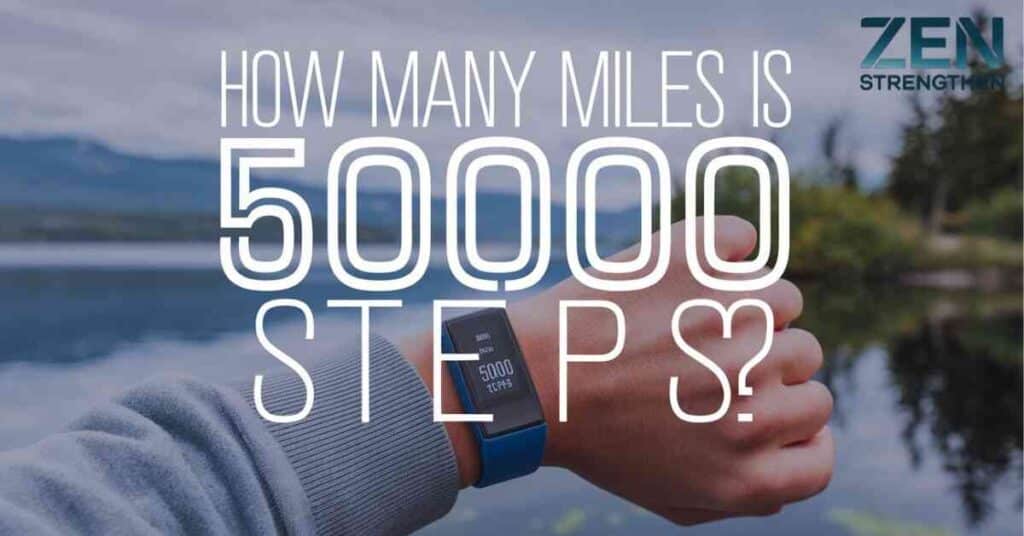Ever wondered how far you’ve really gone when your fitness tracker hits that magical 50000 steps in miles mark? You’re not alone. In our increasingly health-conscious world, step counting has become a popular way to measure daily activity.
But what does 50000 steps actually mean in terms of distance? Let’s lace up our shoes and dive into the fascinating world of step conversion, where we’ll uncover the secrets behind translating those steps into miles. Walking 50,000 steps isn’t just a number it’s a journey.
The Science Behind Step Counting

Before we dive into the nitty-gritty of step conversion, let’s take a moment to appreciate the science that makes step counting possible. The concept of tracking steps isn’t new—it dates back to Leonardo da Vinci’s sketches of a mechanical pedometer. But oh, how far we’ve come!
Today’s step counters are marvels of modern technology. Most rely on accelerometers, tiny sensors that detect motion in three dimensions. When you move, these sensors spring into action, recording the characteristic patterns of walking. It’s like having a tiny, tireless observer watching your every move in a good way!
But here’s the kicker: not all steps are created equal. Your casual stroll to the mailbox registers differently than your power walk in the park. That’s where activity recognition comes into play. Advanced algorithms can distinguish between walking, running, and even climbing stairs, ensuring your step count to miles conversion is as accurate as possible.
Understanding Step Length: The Key to Accurate Distance Measurement
Now, let’s talk about average step length. This seemingly simple measurement is the linchpin in converting your step count to distance. Think of it as your personal conversion factor unique to you.
Your average step length is influenced by several factors:
- Height and leg length
- Age and gender
- Walking speed
- Terrain (flat ground vs. hills)
Here’s a quick guide to estimating your step length:
- Measure a known distance, say 20 feet.
- Walk normally across this distance, counting your steps.
- Divide the distance by the number of steps.
For example, if you took 15 steps to cover 20 feet: 20 feet ÷ 15 steps = 1.33 feet per step
But remember, this is just an average. Your actual step length varies with each stride, which is why fitness tracking devices that account for these variations can provide more accurate distance estimation.
From Steps to Miles: Cracking the Conversion Code
Now for the million dollar question: How do we turn those 50,000 steps into miles? It’s time to put on our math hats and dive into some steps to miles conversion.
The basic formula is simple:
Copy
Distance (miles) = Number of Steps × Average Step Length (feet) ÷ 5,280 (feet in a mile)
Let’s break it down with an example. Say your average step length is 2.5 feet:
Copy
50,000 steps × 2.5 feet = 125,000 feet
125,000 feet ÷ 5,280 feet/mile ≈ 23.67 miles
Voilà! In this scenario, 50,000 steps would equate to about 23.67 miles. But hold your horses this is where things get interesting.
Remember how we said not all steps are equal? Your actual mileage may vary depending on factors like:
- Walking speed (pace)
- Terrain (flat vs. hilly)
- Your physical condition
This is why advanced fitness tracking devices use complex algorithms that factor in these variables for more accurate distance estimation.
The 50000 Step in miles Challenge: What Does It Really Mean?
Taking 50000 steps in a day is no small feat in miles. It’s a challenge that pushes the boundaries of typical daily activity. But what does it really entail?
Let’s put it into perspective:
| Activity Level | Average Daily Steps | Equivalent in 50,000 Step Challenge |
| Sedentary | < 5,000 | 10+ days of activity |
| Low Active | 5,000 – 7,499 | About 7-10 days of activity |
| Somewhat Active | 7,500 – 9,999 | 5-7 days of activity |
| Active | 10,000 – 12,499 | 4-5 days of activity |
| Highly Active | 12,500+ | 3-4 days of activity |
As you can see, 50,000 steps represent a significant increase in activity for most people. It’s not just about the distance—it’s about the commitment and effort required to achieve such a goal.
The Physical Demands: What Your Body Goes Through
Walking 50000 steps isn’t just a casual stroll in miles in the park. It’s a substantial physical undertaking that engages multiple systems in your body. Let’s break down what happens when you embark on this step-counting marathon:
- Cardiovascular System: Your heart rate increases, pumping more oxygen-rich blood to your muscles. This sustained activity can improve heart health and endurance over time.
- Muscular System: Your leg muscles, including quadriceps, hamstrings, and calves, get a serious workout. Don’t be surprised if you feel some muscle fatigue or soreness, especially if you’re not used to this level of activity.
- Skeletal System: Walking is a weight-bearing exercise, which can help strengthen bones and reduce the risk of osteoporosis.
- Respiratory System: Your breathing rate increases to meet the oxygen demands of your active muscles.
- Metabolic System: Your body burns through calories and may tap into fat stores for energy, especially during longer walks.
Caloric Burn: The Energy Cost of 50000 Steps

One of the most exciting aspects of taking 50000 steps in miles is the potential for significant caloric burn. But how many calories are we really talking about?
The number of calories burned depends on several factors:
- Your weight
- Walking speed (pace)
- Terrain
- Overall fitness level
Here’s a rough estimate of calories burned for a 150-pound person walking at a moderate pace:
| Steps | Approximate Distance | Estimated Calories Burned |
| 10,000 | 5 miles | 450-500 calories |
| 20,000 | 10 miles | 900-1,000 calories |
| 30,000 | 15 miles | 1,350-1,500 calories |
| 40,000 | 20 miles | 1,800-2,000 calories |
| 50,000 | 25 miles | 2,250-2,500 calories |
Keep in mind that these are rough estimates. Your actual caloric burn may be higher or lower depending on your individual characteristics and the intensity of your walking.
“The journey of a thousand miles begins with a single step.” – Lao Tzu
Whether you’re a fitness enthusiast pushing your limits or someone curious about the distance estimation of your daily stroll, understanding the relationship between steps and miles can be eye-opening. We’ll explore everything from average step length to caloric burn, giving you a comprehensive look at what it truly means to walk 50000 steps in miles.
This ancient wisdom takes on new meaning when we consider the journey of 50000 steps in miles!
Incorporating 50000 Steps into Daily Life: Strategies and Challenges
Achieving 50000 steps in a day is a lofty goal that requires dedication and creative thinking. Here are some strategies to help you rack up those steps:
- Start Early: Begin your day with a brisk morning walk to kick-start your step count.
- Take the Stairs: Opt for stairs instead of elevators whenever possible.
- Walking Meetings: Suggest walk-and-talk meetings at work.
- Active Commuting: If feasible, walk part or all of your commute.
- Dance Breaks: Turn on some music and dance around your living room.
- Household Chores: Cleaning, gardening, and other household tasks can significantly boost your step count.
- Evening Strolls: End your day with a relaxing walk to wind down and add more steps.
- Use a Treadmill Desk: If you work from home, consider investing in a treadmill desk for multitasking.
Remember, the goal is to make movement a natural part of your day, not to stress yourself out. Listen to your body and gradually increase your activity level.
Technology and Tools: Your Allies in Step Counting
In the quest for 50000 steps, technology can be your best friend. The world of fitness tracking has exploded in recent years, offering a plethora of options for monitoring your steps and other health metrics.
Here’s a rundown of some popular tools:
- Smartwatches: Devices like Apple Watch, Fitbit, and Garmin offer comprehensive tracking, including steps, heart rate, and GPS.
- Smartphone Apps: Many phones have built-in step counters, and apps like Google Fit or Samsung Health can provide additional insights.
- Dedicated Pedometers: Simple, clip-on devices that focus solely on step counting.
- Smart Scales: While not step counters themselves, these can integrate with your fitness apps to provide a more complete picture of your health.
When choosing a device, consider factors like:
- Accuracy
- Battery life
- Additional features (heart rate monitoring, sleep tracking, etc.)
- Compatibility with your existing devices
- Water resistance for outdoor use
So, grab your pedometer, and let’s embark on this 50000 steps distance adventure together in miles. By the end of this article, you’ll have a clear picture of just how far those feet can take you and why every step counts towards your health and fitness goals.
Remember, the best device is the one you’ll actually use consistently!
Beyond Step Count: A Holistic Approach to Walking for Fitness
While reaching 50000 steps is an impressive goal in miles, it’s important to remember that quality matters as much as quantity. Here are some ways to enhance the effectiveness of your walking routine:
- Vary Your Pace: Incorporate intervals of brisk walking or even light jogging to increase intensity.
- Add Inclines: Walking uphill or on a treadmill with an incline can boost calorie burn and muscle engagement.
- Use Walking Poles: Nordic walking with poles can engage your upper body and increase overall calorie burn.
- Practice Mindful Walking: Focus on your breath and surroundings to turn your walk into a moving meditation.
- Incorporate Balance Exercises: Try walking heel-to-toe or practice standing on one leg during breaks.
Remember, the goal is overall health and fitness, not just a number on your step counter.
Case Studies: Real People Achieving 50000 Steps
Let’s look at some real-life examples of individuals who’ve taken on the 50000 step challenge:
- Sarah, 35, Office Worker:
- Strategy: Woke up early for a 5-mile run, took walking meetings, used a treadmill desk for 2 hours, and ended the day with a long walk with her dog.
- Result: Achieved 52,463 steps and reported feeling energized and accomplished.
- Mark, 50, Teacher:
- Strategy: Led active classroom activities, walked during lunch break, coached after-school sports, and did an evening workout.
- Result: Reached 51,789 steps and noticed improved sleep quality.
- Lisa, 28, Tour Guide:
- Strategy: Conducted walking tours throughout the day, took the stairs in museums, and added an evening jog.
- Result: Hit 55,102 steps and felt a boost in her overall stamina.
These stories show that while challenging, achieving 50000 steps is possible with planning and dedication.
Debunking Myths About High Step Counts
As with any fitness trend, there are myths surrounding high step counts. Let’s address some common misconceptions:
- Myth: 10,000 steps is the magic number for health. Truth: While 10,000 steps is a good goal, health benefits can be seen at lower and higher step counts. The right number depends on individual factors.
- Myth: More steps always equal better health. Truth: Quality of movement matters. Varied intensity and types of activity contribute to overall fitness.
- Myth: You need expensive equipment to track high step counts. Truth: While advanced devices offer more features, simple pedometers or smartphone apps can be effective for basic step counting.
- Myth: Walking 50,000 steps burns the same calories for everyone. Truth: Calorie burn varies based on individual factors like weight, pace, and metabolism.
- Myth: Achieving a high step count negates the need for other forms of exercise. Truth: A well-rounded fitness routine should include strength training and flexibility exercises in addition to walking.
Future Trends in Step Counting and Fitness Tracking
The world of fitness tracking is ever-evolving. Here are some exciting trends to watch:
- AI-Powered Personalization: Devices that learn your habits and provide tailored recommendations.
- Advanced Gait Analysis: More detailed insights into your walking patterns for injury prevention and performance optimization.
- Integration with Smart Home Devices: Your step count could influence your home’s lighting or temperature settings.
- Virtual Reality Walks: Combining step counting with immersive virtual environments for more engaging exercise experiences.
- Biometric Authentication: Using your unique walking pattern as a security feature.
As technology advances, our ability to understand and optimize our movement will only grow.
Conclusion
The journey of 50,000 steps is more than just a number—it’s a commitment to an active lifestyle. While it’s an impressive goal, it’s important to remember that fitness is not one-size-fits-all.
Here are some key takeaways:
- Understanding your average step length is crucial for accurate distance estimation.
- Fitness tracking devices can provide valuable insights, but listening to your body is equally important.
- Incorporating high step counts into your routine requires creativity and dedication.
- Quality of movement matters as much as quantity—vary your pace and terrain for optimal benefits.
- Always consult with a healthcare professional before dramatically increasing your activity level.
Whether you’re aiming for 5,000 steps or 50,000, the most important thing is to keep moving. Every step is a step towards better health. So lace up those shoes, start your step count to miles journey, and see where your feet can take you!
FAQ,s
How many miles is 50,000 steps?
The distance covered in 50,000 steps varies depending on your average step length, but it typically ranges from 22 to 25 miles.
What is the average step length for adults?
The average step length for adults is about 2.5 feet, but this can vary based on height and walking style.
How can I calculate the calories burned from walking 50,000 steps?
To estimate calories burned, consider your weight and walking speed. On average, a person burns about 100 calories per mile, so walking 50,000 steps may burn between 2,200 to 2,500 calories.
What are the benefits of walking 50,000 steps a day?
Walking this amount can improve cardiovascular health, boost mood, aid weight management, and enhance overall fitness levels.
How can I track my steps effectively?
Using a pedometer, fitness tracker, or smartphone app can help you monitor your step count and walking distance effectively
Disclaimer
“This article” is intended for general informational purposes only and does not address individual circumstances. It is not a substitute for professional advice or help and should not be relied on to make decisions of any kind. Any action you take upon the information presented in this article is strictly at your own risk and responsibility!

Jhon Wick is a seasoned writer in the fitness niche, dedicated to sharing expert advice and the latest trends. With a passion for health and wellness, Jhon offers practical tips and inspiration to help readers achieve their fitness goals and stay motivated.







